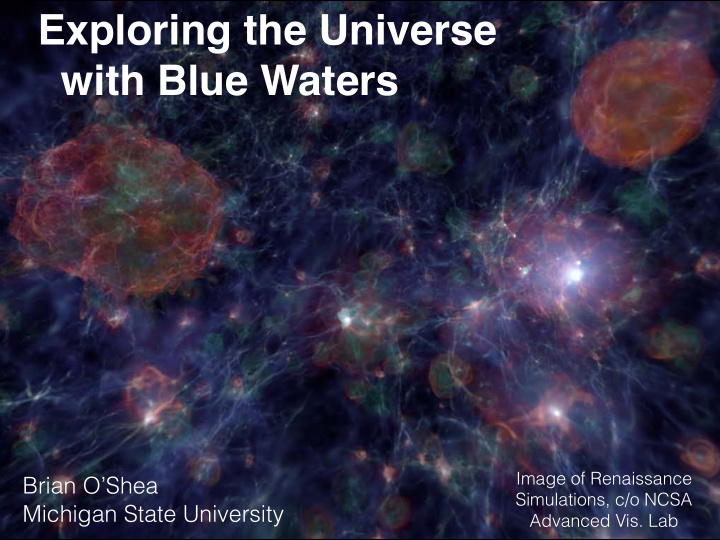



Exploring the Universe with Blue Waters Image of Renaissance Brian O’Shea Simulations, c/o NCSA Michigan State University Advanced Vis. Lab
My charge : Review the impact of Blue Waters on astronomical and space sciences over the past five years. (In 30 minutes, including Q&A)
Some questions: 1. Why do the fields of astronomy, astrophysics, and space science desperately need large- scale (and high-performance) computing? 2. Why is Blue Waters particularly awesome for scientific challenges in these areas? 3. What science has been done on Blue Waters in these fields?
Thank you to: • All of the scientists who generously shared their time, thoughts, plots, and animations for this talk • Bill Kramer and the rest of the Blue Waters team for their hard work and dedication • The NSF for funding the Blue Waters project • Funding and computing time for my research from NSF, NASA, DOE, the GLCPC, and Michigan State University
The need for HPC Problems in astronomy, astrophysics, and space science… • Are often in physical regimes where you can’t do experiments on Earth • Are physically complex and involve huge dynamical range • Sometimes deal with huge numbers of objects (of stars, galaxies, etc.)
How has Blue Waters contributed? • The hardware is well-suited to these problems • Lots of computing time: 25% of allocated Blue Waters time has gone to astronomical and space science • Blue Waters Student Internship Program, Graduate Fellowship Program, Petascale Institute, and other educational and outreach efforts (along with GLCPC and Shodor)
And now, the science! (And pretty pictures, and amazing movies!)
Earth and the Solar system Image c/o NASA
Modeling the formation of the terrestrial planets (Clement) Gas giants formed first and stunted Mars’ growth!
Space weather • Combined MHD+Embedded PIC codes: first 3D global studies of solar wind/magnetosphere interaction w/MHD +kinetics (Toth/Manchester) • Dissipation of turbulence in solar wind-like plasmas: “SpectralPlasmaSolver” (Roytershteyn+) • Global simulations of interaction of solar wind with the interstellar medium (heliopause and heliotail), explanation of Voyager 1 & 2 observations (Pogorelov, Bedford) • 3D PIC simulations of the magnetic reconnection “x-line” maximizes reconnection rate, with less turbulence than expected (Liu+)
Magnetic fields at interface of solar wind and local interstellar medium Movie c/o Nick Pogorelov
Solar wind interacting with Earth’s magnetic field Simulation: Karimabadi, Roytershteyn Movie: NCSA Advanced Viz Lab
Stellar Evolution SN 1054 Image c/o NASA+ESA
Core-collapse supernovae • Explored 3D morphology and behavior of neutrino-driven supernova explosions in massive stars (Burrows) • Demonstrated that MRI can power hypernovae by powering a large-scale dynamo (Mösta) • Study of resolution dependence of turbulence in Type II supernovae and its effect on explosion mechanism (Lentz, Mösta, Ott, Radice)
Castro Type II SN explosion (rotating) Credit: Burrows
Supernova turbulence resolution study (c/o Mösta) 2x resolution 4x Reference resolution run 12x resolution
Compact object mergers • Blue Waters contributed to LIGO’s detection of a neutron star binary merger through signal analysis (Huerta/Haas) • Generated hundreds of gravitational waveform models for black hole binary mergers + surrogate model for rapid fitting (Scheel + Teukolsky) • First full GR-MHD simulations demonstrating that a neutron star-black hole merger can create a jet that triggers a gamma ray burst (Shapiro)
Binary neutron star merger (c/o NCSA Gravity Group, Data Analytics & Viz Group)
Magnetic fields from GR+MHD simulations of supermassive black holes + accretion disks c/o Scott Noble
Optical emission from GR+MHD simulations of supermassive black holes + accretion disks c/o Scott Noble
Hydrogen ingestion c/o Paul Woodward
Galaxy formation M31; image c/o Robert Gendler
Super-Massive Black Holes • The most massive black holes in the universe grow in compact, spheroidal galaxies at high redshift (DiMatteo) • Stellar mass black holes are unlikely to be SMBH progenitors, but there are plausible mechanisms for the “direct collapse” scenario (O’Shea/Wise/Norman) • First prediction of time scales for close SMBH pairs following galaxy mergers (Quinn) • “Zoom” galaxy simulations showing growth of SMBHs by short bursts of accretion (Hopkins/Faucher-Giguère)
BlueTides: DiMatteo
BlueTides: DiMatteo
The Renaissance Simulations Calculations: O’Shea/Wise/Norman Visualization: NCSA Advanced Visualization Lab
FIRE simulations (Hopkins/Faucher-Giguère)
Multi-group radiation transport: reionization of H, He in the intergalactic medium (Norman)
Multi-group radiation transport: reionization of H, He in the intergalactic medium (Norman)
Cosmic ray-driven galactic outflows (Butsky) Temp. projection Temp. slice Anisotropic CR diffusion CR streaming
Concluding thoughts • Astronomical and space science relies on large- scale computing to make progress • Blue Waters has been a unique and indispensable resource for these communities over the past five years • Fundamental advances have been made at all scales, from the Earth’s magnetosphere to the edge of the Universe!
Recommend
More recommend